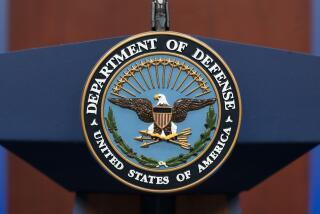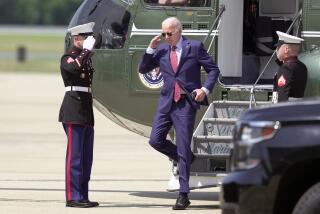Relax Taxpayers, This War’s Weaponry Is Paid for
WASHINGTON — Operation Desert Shield, which involved the deployment of over 400,000 American military men and women to the Persian Gulf, and Operation Desert Storm to liberate Kuwait are prohibitively expensive military operations. To maintain a single Army division for a year costs $3 billion, an Air Force tactical wing $1 billion and a Navy carrier air wing $5 billion. The total cost of deploying and maintaining eight army divisions, 10 tactical air squadrons, two Marine Expeditionary forces and six carrier battle groups in the Middle East for a full year will amount to about $130 billion.
Military hardware and munitions are also very expensive. The cost of single fighter aircraft can be as high as $50 million, while each Tomahawk or Patriot missile fired against Baghdad or its missiles is more than $1 million; even a single smart bomb can cost several thousand dollars. The replacement cost of the material currently being expended in the air campaign against Iraq and Kuwait is an additional $700 million a day. If ground troops join the fray, the costs of Desert Storm would rise to $2 billion a day.
With costs of this magnitude, it is not surprising that the Bush Administration refused to allow representatives from the defense and state departments to appear before a recent hearing of the House Budget Committee to discuss the current and future costs of the Persian Gulf operation. However, if appropriate measures are taken, neither Desert Shield nor Desert Storm should cost the American taxpayer more than the $300 billion the Defense Department already receives each year. Nor should the war cheat the American taxpayer out of the peace dividend earned after spending $8 trillion to bring about the collapse of the Soviet empire and Soviet expansionism.
The reason for this is simple. Prior to the Iraqi invasion, the United States possessed the world’s strongest military force equipped with a vast amount of the most up-to-date equipment. Raising and equipping this force has cost us almost $3 trillion over the past decade. For 1991 alone, the cost, without Desert Shield or Desert Storm, would have been almost $300 billion.
The $130 billion worth of people and equipment deployed to the gulf is already covered in the annual defense budget. Military people receive their salaries whether they are in Saudi Arabia or San Diego; operating a carrier task force costs the same whether it is steaming off the west coast of Iraq or of the United States; an F-15 fighter wing costs the same to fly whether it is in Riyadh or Reno, and a Marine amphibious force costs the same to deploy to the Persian Gulf or the Pacific.
Thus, the potential additional or incremental cost to the taxpayer for Desert Shield involves paying only for such items not part of the normal defense budget--the cost of moving troops and equipment, paying combat pay and constructing new military facilities in Saudi Arabia. For 1990, these costs will amount to $10 billion. Our allies have pledged about $8 billion--or 80% of the incremental costs. The Pentagon can easily cover the remaining $2 billion by reducing its activities outside the gulf. For example, the Navy can reduce some of its deployments in the Western Pacific and the Army and Air Force can curtail training exercises in the European theater.
There will be additional costs. The U.S. fighters and bombers flying about 1,500 missions or sorties a day against military installations in Iraq and the Iraqi troops in Kuwait consume prodigious amounts of fuel--worth about $50 million a day. The bombs dropped and the missiles fired by these planes cost about $400 million daily, while lost planes average about $75 million a day. The ammunition and material that could be expended or lost in a ground campaign would be an additional $1 billion a day. Thus, if the war lasts for a month at this level of intensity, the additional costs could amount to between $18 and $60 billion.
Not surprisingly, this has led to calls in Congress for a war surtax. But this should not be necessary unless the war goes on for longer than two months. Why? Because the costs of the operation against Iraq are replacement costs of the equipment used or destroyed. Much of this equipment will not have to be replaced or would have been replaced anyway in the normal cycle of modernization.
Much of the equipment will not have to be replaced because the force structure that the United States has hurled against Iraq was built to fight the Soviet Union and its former East European allies. This force is in the process of being reduced. Indeed, last Aug. 2, right after the Iraq invasion, President Bush announced that the Defense Department would reduce the size of the force by 25% by 1995.
In the budget summit agreement concluded last September, the Congress and the Administration agreed to reduce defense spending by 15% between 1990 and 1993. The force envisioned by the President and Congress for the mid-1990s would cut six Army divisions, 11 Air Force tactical wings, 75 ships and two carrier battle groups. There is no way that this nation would consume that much equipment in this war. For example, reducing the Air Force by 11 tactical air wings would mean it would need 700 fewer aircraft. Moreover, even in peacetime, over 200 planes a year must be replaced because of accident and old age.
It is true that some munitions expended will have to be replaced, particularly the smart munitions. However, not all of these will have to be replaced on a one-for-one basis. The Pentagon has, or is in the process of purchasing, 2,000 Tomahawks for its 600-ship Navy and 4,000 Patriots, primarily for defense of U.S. forces in Europe. At the end of this war, the United States will still have thousands of these missiles in its inventory, and it will have a 500-ship Navy and no real threat in Europe.
The true replacement costs of the equipment involved in Desert Storm should be no more than about $100 million a day or $3 billion a month, a sum that can be absorbed easily by our more affluent allies like Saudi Arabia, Japan and Germany--and by some discrete reprogramming in the defense budget. Indeed, since the outbreak of war, the Germans and Japanese have already agreed to increase their monetary contribution.
Finally, there is a theory in some Washington circles that the war against Iraq has shown that the President and Congress acted too hastily in cutting defense spending. Indeed, last November, Defense Secretary Richard B. Cheney argued that the gulf crisis proves that the U.S. defense budget must remain large despite the end of the Cold War.
Nothing could be further from the truth. The American force fighting so magnificently in the desert, while substantial, is only about 15% of our total force, that is, active and selected reserve. If the force cuts already agreed to by the Congress and Bush for 1995 had been in place, the United States would still have had 24 ground divisions, 27 tactical fighter wings, 11 carrier battle groups and 480 ships--substantially more than the current force in the gulf.
Others have used the gulf crisis to justify the continued procurement of such Cold War weapons as the B-2 or the Strategic Defense Initiative. This, too, is the wrong way to go. Our current generation of aircraft has had no problem in penetrating Iraqi air defenses; the anti-missile Patriot, an upgrade of 25-year-old air defense technology, has a nearly perfect record against the Iraqi Scuds.
The United States was correct to deploy force to the Persian Gulf to liberate Kuwait. The financial costs of this operation will be substantial. However, because of the large amounts of money this nation has spent on defense in the past decade, and because of the contributions that can be given by our more wealthy neighbors, the additional funds required from the U.S. taxpayer will be minimal. The human cost, of course, will be immeasurable.
Nor does the Persian Gulf operation justify keeping the anti-Soviet military force. After all, Iraq’s gross national product equals only 10% of the current U.S. defense budget. There are some who will use the war in the gulf to accomplish other goals. We should not let them.
More to Read
Sign up for Essential California
The most important California stories and recommendations in your inbox every morning.
You may occasionally receive promotional content from the Los Angeles Times.










